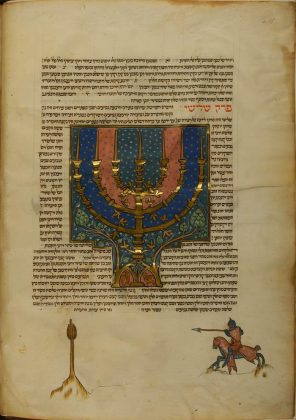
At the Jewish Museum of Budapest, a replica of a tombstone dating from the third century bears the image of a menorah. This relic attests to nearly 1700 years of Jewish presence in the Carpathian basin, predating that of the Magyar tribes who broke free from the confines of the Ural Mountains during the ninth century. The modern history of Judaism in Hungary goes all the way back to settlement by Bohemian, Moravian, and German Jews here during the eleventh century. Under Ottoman occupation (1526-1686), tens of thousands of Sephardic Jews from Spain took refuge within the empire’s borders. The country was then taken back in 1686 by the Habsburgs, unleashing a wave of pogroms. Considered as collaborators with the forces of Ottoman occupation, Jews were either massacred or expelled. They did not return until the late eighteenth century, encouraged by Joseph II’s policy of tolerance. From that point until the twentieth century, two distinct Jewish communities coexisted in Hungary. One, of Moravian and German origin, settled in both the country’s western regions and in Budapest; the other, made up mostly by Hasidism, settled in the Northeast.
In 1840, Jews in Hungary became the first to enjoy freedom of trade within the Habsburg Empire. The nation counted around 340000 Jews at the time, many of whom enlisted in the army during the war of independence from Austria in 1848 and 1849.
The 1860s saw the rapid development of the city of Pest, where Jews had a significant presence. Meanwhile, the community’s poorest members were leaving their villages for the city to earn a living.
A sort of tacit “social contract” was developing: the Magyar nobility restricted itself to administration and political careers, gladly leaving the industrial and financial spheres to the Jews, who possessed both capital and know-how. With the passage of the 1867 law of emancipation, Jews were granted full civil rights. They were called upon in exchange to assimilate and “Magyarize”- the Hungarian language defining nationality at the time. But as François Fejtö has pointed out in his work Hongrois et juifs : Histoire millénaire d’un couple singulier (Hungarians and Jews: 1000-Year-Old History of a Singular Couple [Paris: Balland, 1997]): “The historical Magyar class had another reason to grant Jewish civil rights. This was their desire to reinforce the weight of Magyar speakers in a country where Hungarians…held only a weak majority of 51,4% at the turn of the century, and this thanks to the support of assimilated Jews and Germans. Thus the Jews’ choice of language took on special meaning, causing the demographic balance to tilt toward the Magyar side”, a fact of primary importance, for the Magyar kingdom faced an upsurge in nationalism by other minority groups living under its control.
Despite the 1870 schism between the progressive Neolog Jews and the Orthodox community, the turn of the twentieth century marked a golden age of assimilation. In 1900, 72% of Jews were listed as Magyars. In 1910, Jews numbered 203000 in Budapest -not including converts- or 23% of the city’s population, while in Vienna and Prague they made up respectively only 8% and 5% of the population.
Between the wars, they represented only 6% of the population, though half of all merchants, manufacturers, and bankers were Jewish. In 1940, Jews owned 40% of the property in Budapest.

In 1919, the dismemberment of the Hapsburg Empire altered the political landscape. Mutilated by the 1920 Treaty of Trianon, Hungary lost two-thirds of its territory. The conservative regent Horthy took the reins of the country, while Jews were becoming the target of increasing anti-semitism. Hungary became the first European country to reintroduce anti-Jewish legislation, notably the numerus clausus of 1920, though this law was unevenly applied. Horthy’s irredentist politics, meanwhile, led him into an alliance with Hitler. When the war began, this approach paid off, as Hungary quickly regained all its lost provinces. Although Horthy managed to resist Hitler’s pressure for a time, he was forced to appoint a pro-nazi government when German troops occupied the country in March 1944, resulting in the deportation of hundreds of thousands of Jews. Veesenmayer, Hitler’s plenipotentiary in Hungary, declared not long after: “Thanks only to the zealous and full participation of the Hungarian police apparatus have we succeeded in completing our task in less than three months”.
Dispossessed of their belongings, 600000 Hungarian Jews -of a total of 900000- were deported. Practically every Jews from the provinces was liquidated, though half of those from Budapest (around 120000) managed to survive the Shoah.
Today, the Hungarian-Jewish community is estimated at around 100000, centered mostly in Budapest. There has been an undeniable reawakening of Jewish identity here. The newfound presence of newspaper, schools, organisations, and klezmer bands attests to a cultural rather than religious renaissance. Hungarian society has not yet settled its account with history; as François Fejtö has remarked: “No one has yet expressed, in the name of the nation, condemnation of shame regarding Hungary’s complicity, and history books remain surprisingly quiet on the subject”.
We Budapest !
Visit Budapest and Hungary’s Jewish heritage with the experienced guide Brigitta Ladányiné Zemba and enjoy and 10% discount with the code “JGuide Europe”